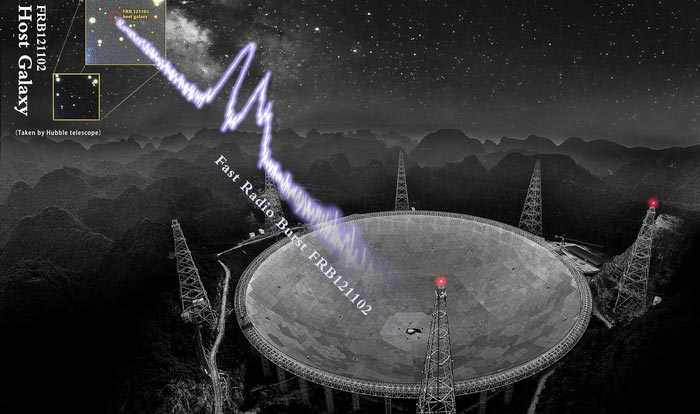Over a thousand cosmic explosions in 47 days detected by FAST

FAST catches a real pulse from FRB 121102
Credit: NAOC
An international research team led by Prof. LI Di and Dr. WANG Pei from National Astronomical Observatories of Chinese Academy of Sciences (NAOC) caught an extreme episode of cosmic explosions from Fast Radio Burst (FRB) 121102, using the Five-hundred-meter Aperture Spherical radio Telescope (FAST). A total of 1,652 independent bursts were detected within 47 days starting Aug. 29, 2019 (UT).
It is the largest set of FRB events so far, more than the number reported in all other publications combined. Such a burst set allows for the determination, for the first time, of the characteristic energy and energy distribution of any FRB, thus shedding light on the central engine powering FRBs.
These results were published in Nature on Oct. 13, 2021 (US Eastern Time).
FRBs were first detected in 2007. These cosmic explosions can be as short as one-thousandth of a second while producing one year’s worth of the Sun’s total energy output. The origin of FRBs is still unknown. Although even aliens have been considered in models for FRBs, natural causes are clearly favored by the observations. The recent focuses include exotic hyper-magnetized neutron stars, black holes, and cosmic strings left over from the Big Bang.
Scientists have found that a small fraction of FRBs repeat. This phenomenon facilitates follow-up studies, including localization and identification of FRBs’ host galaxies.
FRB 121102 is the first known repeater and the first well-localized FRB. Scientists have identified its origin in a dwarf galaxy. In addition, this FRB is clearly associated with a persistent radio source. Both clues are crucial to solving the cosmic mystery of FRBs. The behavior of FRB 121102 is hard to predict and commonly described as “seasonal.”
While testing the FAST FRB backend during the commissioning phase, the team noticed that FRB 121102 was acting up with frequent bright pulses. Between Aug. 29 and Oct. 29, 2019, 1,652 independent burst events were detected in a total of 59.5 hours. While the burst cadence varied during the series, 122 bursts were seen during the peak hour, corresponding to the highest event rate ever observed for any FRB.
Such high cadence facilitates a statistical study of these FRB bursts. The researchers found a clear characteristic energy of E0= 4.8 × 1037 erg, below which the generation of the bursts became less efficient. The burst energy distribution can be adequately described as bimodal, namely, a log-normal function for low E bursts and a Lorentz function for high E bursts, implying that weaker FRB pulses may be stochastic in nature and the stronger ones involve a ratio between two independent quantities.
“The total energy of this burst set already adds up to 3.8% of what is available from a magnetar and no periodicity was found between 1 ms and 1000 s, both of which severely constrains the possibility that FRB 121102 comes from an isolated compact object,” said Dr. WANG.
More than six new FRBs have been discovered through the Commensal Radio Astronomy FAST Survey (CRAFTS, https://crafts.bao.ac.cn/), including one new 121102-like repeater. “As the world’s largest antenna, FAST’s sensitivity proves to be conducive to revealing intricacies of cosmic transients, including FRBs,” said Prof. LI.
This project has been part of a long-running collaboration since the commissioning phase of the FAST telescope. Major partner institutions include Guizhou Normal University, University of Nevada Las Vegas, Cornell University, Max-Planck-Institut fuer Radioastronomie, West Virginia University, CSIRO, University of California Berkeley, and Nanjing University.
Journal: Nature
DOI: 10.1038/s41586-021-03878-5
Article Title: A Bimodal Burst Energy Distribution of a Repeating Fast Radio Burst Source
Article Publication Date: 13-Oct-2021
Media Contact
XU Ang
Chinese Academy of Sciences
annxu@nao.cas.cn
Original Source
All latest news from the category: Physics and Astronomy
This area deals with the fundamental laws and building blocks of nature and how they interact, the properties and the behavior of matter, and research into space and time and their structures.
innovations-report provides in-depth reports and articles on subjects such as astrophysics, laser technologies, nuclear, quantum, particle and solid-state physics, nanotechnologies, planetary research and findings (Mars, Venus) and developments related to the Hubble Telescope.
Newest articles

Sea slugs inspire highly stretchable biomedical sensor
USC Viterbi School of Engineering researcher Hangbo Zhao presents findings on highly stretchable and customizable microneedles for application in fields including neuroscience, tissue engineering, and wearable bioelectronics. The revolution in…

Twisting and binding matter waves with photons in a cavity
Precisely measuring the energy states of individual atoms has been a historical challenge for physicists due to atomic recoil. When an atom interacts with a photon, the atom “recoils” in…

Nanotubes, nanoparticles, and antibodies detect tiny amounts of fentanyl
New sensor is six orders of magnitude more sensitive than the next best thing. A research team at Pitt led by Alexander Star, a chemistry professor in the Kenneth P. Dietrich…





















